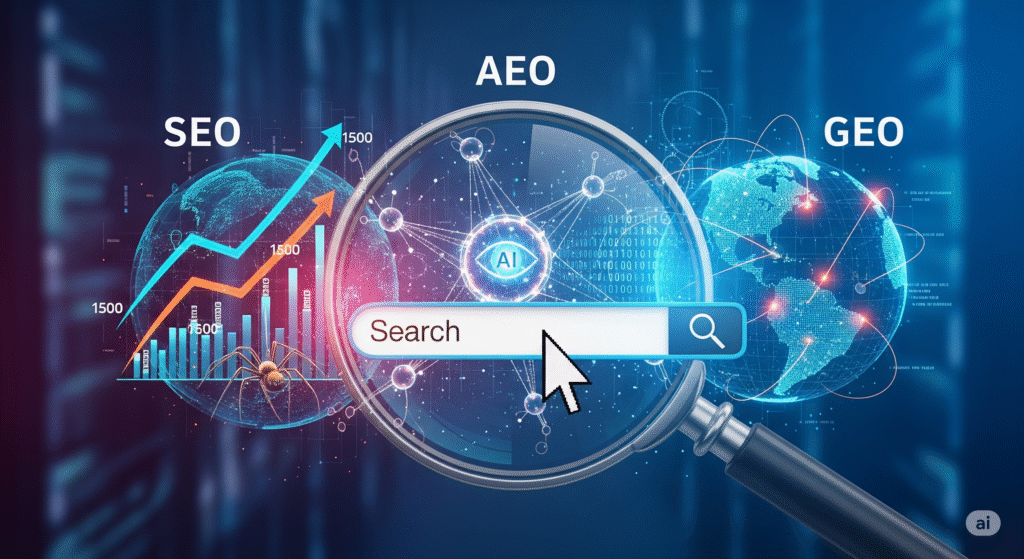If you’ve been navigating the evolving world of digital marketing, you’ve likely encountered the terms SEO, AEO, and GEO — three pillars shaping how content gains visibility in 2025. Traditional SEO, focused on keywords and backlinks, remains essential, but the rise of AI-driven technologies has given birth to Answer Engine Optimization (AEO) and Generative Engine Optimization (GEO), transforming how search engines like Google present information to users. Understanding how SEO, AEO, and GEO interplay is vital for anyone aiming to optimize content for search engines, voice search, featured snippets, and direct answers.
This article guides you through these AI-driven changes, helping you master the new strategies in search optimization and digital marketing by leveraging structured data, schema markup, and user-focused content to boost your visibility in an increasingly complex search landscape.
Understanding SEO, AEO, and GEO

SEO: The Foundation of Digital Visibility
Search Engine Optimization (SEO) is the cornerstone of digital marketing, focusing on improving your website’s visibility on traditional search engines like Google. It involves a blend of technical SEO, on-page content optimization, and off-page strategies such as building quality backlinks.
Properly implemented SEO ensures your site is crawlable, indexed, and ranks well in organic search results by addressing site speed, mobile optimization, metadata, and structured data schema. In 2025, mastering SEO means maintaining a solid foundation while adapting to emerging trends, enabling you to attract high-quality, relevant traffic to your site effectively.
AEO: Tailoring for Precision in Answers
Answer Engine Optimization (AEO) represents the evolution of SEO centered around delivering precise, direct answers to user queries. Unlike traditional SEO, which prioritizes ranking pages, AEO focuses on optimizing content to appear in featured snippets, direct answers, and voice search results.
This approach leverages structured data, schema markup, and detailed, user-focused content to satisfy increasingly conversational and voice-activated search engines. Leveraging AEO strategies improves your chances of being the direct answer source in an AI-driven search ecosystem where users expect immediate, clear responses beyond simple link lists.
GEO: The Frontier of AI in Search
Generative Engine Optimization (GEO) is the newest frontier where AI-powered generative engines create rich, context-aware responses by synthesizing information across multiple sources. This AI-driven approach extends beyond retrieving links or direct answers — it generates unique content and insights in real time, reshaping how users interact with search engines.
GEO requires a strategic integration of SEO and AEO principles while aligning content with data signals that AI engines prioritize, including relevance to user intent, quality of structured data, and digital marketing alignment. Embracing GEO means optimizing not just for discovery but for being part of the generated answers in today’s digital marketing landscape.
Challenges and Opportunities Faced in 2025

Keeping Up with AI Algorithms
The rapidly evolving AI algorithms powering modern search engines present a significant challenge for marketers and content creators alike. With continuous updates in how Google and generative engines interpret queries—especially around voice search and answer engines—staying ahead requires constant learning and adaptation. These algorithms increasingly prioritize context, user intent, and structured data over traditional keyword signals. This means your optimization efforts must go beyond classic SEO techniques to include AI-driven signals that influence ranking and visibility.
Integrating Multi-dimensional Optimization
In 2025, optimizing for SEO, AEO, and GEO simultaneously is both a complex challenge and a huge opportunity. Multi-dimensional optimization involves creating content that not only ranks well in organic search but also appears in direct answer boxes and is cited by generative AI engines.
This requires a blend of strategies, such as implementing structured data, optimizing for voice search, and using geo-targeted content marketing. The payoff is greater visibility across multiple digital touchpoints—traditional search engines, voice assistants, and AI-powered answer systems—helping your brand capture relevant traffic regardless of how users seek information.
Privacy and Data Ethics
As AI-driven search technologies increasingly rely on user data to refine results, privacy concerns and data ethics have become prominent hurdles. With tighter regulations on data collection and search engines respecting user privacy preferences, marketers face new challenges in gathering and using data for optimization in GEO and AEO efforts. Balancing effective personalization with ethical standards means marketers must prioritize transparent data practices and leverage anonymized or aggregate data signals. These practices not only influence generative engine optimization but also help maintain trust with users in a privacy-conscious digital ecosystem.
The Convergence of SEO, AEO, and GEO

Building a Unified Strategy
As SEO, AEO, and GEO continue to evolve, the most effective digital marketing strategies in 2025 integrate these approaches into a single, cohesive plan. Building a unified strategy means balancing the foundational principles of traditional SEO—like backlinks and core web vitals—with AEO’s focus on direct answer optimization and GEO’s emphasis on influencing generative AI engines.
This holistic approach enables you to maximize visibility across multiple platforms, capturing users whether they prefer traditional search engines, voice assistants, or AI-generated responses. Success depends on harmonizing content quality, structured data, and user intent to serve the diverse needs of search engines and answer engines alike.
Impact on Content Creation
The convergence reshapes how you create content. Instead of solely targeting keyword rankings, your content must now be optimized to provide concise, accurate answers suitable for featured snippets and voice search, while also being authoritative enough to be cited by generative engines.
This means adopting a modular content structure—combining short answer blocks for AEO with in-depth, well-researched sections for SEO—and embedding schema markup to enhance data clarity. By anticipating multi-channel user journeys, your content becomes more adaptable, engaging, and effective across traditional and AI-driven search experiences.
Tools and Technologies
To navigate this convergence, leveraging advanced SEO and digital marketing tools is essential. Platforms like Google Search Console provide insights into traditional SEO performance, while specialized tools analyze featured snippet opportunities and voice search metrics for AEO. Meanwhile, emerging platforms focus on how generative engines interact with your content, highlighting citation potential and AI relevance.
Incorporating structured data testing tools and voice search simulators into your workflow ensures your content aligns with the evolving algorithms of search engines and answer engines. Combining these technologies supports a forward-thinking optimization strategy that embraces the full spectrum of engine optimization.
Conclusion
As you move forward in 2025, remember that SEO, AEO, and GEO are not isolated strategies but interconnected approaches that should work together to enhance your digital visibility. Traditional SEO provides the foundational groundwork, while AEO ensures your content delivers precise answers for voice search and featured snippets. Meanwhile, GEO focuses on optimizing for emerging AI-driven generative engines.
The key to success lies in adopting a unified approach—leveraging structured data, optimizing for user intent, and embracing AI-powered tools.
Start integrating these elements into your digital marketing strategy today to remain competitive and build meaningful connections with your audience.
FAQ
What is AEO and GEO in SEO?
AEO (Answer Engine Optimization) is the process of optimizing content to directly address user queries for AI-powered platforms. It focuses on elements like featured snippets, voice assistants, and AI-generated summaries, rather than solely driving website traffic as traditional SEO does. GEO (Generative Engine Optimization) is another term for AEO, highlighting the shift towards optimizing content for AI-generated responses instead of conventional search rankings.
What are AEO and GEO?
AEO (Authorized Economic Operator) is a customs status granted to businesses involved in international trade. It confirms compliance with security and regulatory standards, offering benefits such as faster customs clearance and reduced inspections. GEO is not clearly defined in the provided context.
What is AEO and SEO?
AEO (Authorized Economic Operator) is a designation by customs authorities for businesses that meet specific security and compliance standards. It allows for simplified procedures and quicker clearance in international trade. On the other hand, SEO (Search Engine Optimization) is unrelated to customs. It involves optimizing websites to achieve higher rankings in search engine results, focusing on attracting organic traffic.
What is SEO and GEO?
SEO (Search Engine Optimization) is the practice of improving a website’s visibility and ranking in organic search engine results. This is achieved by optimizing content, keywords, and site structure to attract more qualified traffic. GEO often refers to geographic targeting or location-based services in digital marketing, aiming to enhance local optimization for better regional relevance.

